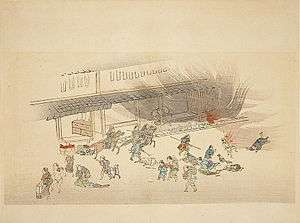Kinmon incident
| Kinmon incident 禁門の変・蛤御門の変 | |||||||
|---|---|---|---|---|---|---|---|
| Part of Bakumatsu conflicts | |||||||
 An 1893 woodblock print by Yūzan Mori, depicting the Hamaguri rebellion. | |||||||
| |||||||
| Belligerents | |||||||
|
Sonnō Jōi Rōnin force |
Kuwana Domain Ōgaki Domain Echizen Domain Hikone Domain Yodo Domain Asao Domain Mimawarigumi Yūgekitai | ||||||
| Commanders and leaders | |||||||
| Tokugawa Yoshinobu | |||||||
| Strength | |||||||
| 3,000 men (1,400 Chōshū army + 1,600 Rōnin force) | 50,000 men | ||||||
| Casualties and losses | |||||||
| 400 killed or wounded |
60 killed or wounded, 28,000 houses burnt down | ||||||
The Kinmon incident (禁門の変 Kinmon no Hen, "Forbidden Gate Incident" or "Imperial Palace Gate Incident"), and is also known as, the Hamaguri Gate Rebellion (蛤御門の変 Hamaguri Gomon no Hen "Hamaguri Imperial Gate Incident") was a rebellion against the Tokugawa Shogunate that took place on August 20, 1864, at the Imperial Palace in Kyoto. The rebellion reflected the widespread discontent felt among both pro-imperial and anti-foreigner groups, who rebelled under the sonnō jōi slogan. The Sonnō Jōi, had been promulgated by the Emperor Kōmei as an "Order to expel barbarians." Thus, in March 1863, the rebels sought to take control of the Emperor, in order to restore the Imperial household to its position of political supremacy.
During what was a bloody crushing of the rebellion, it was the leading Chōshū clan that was held responsible for its instigation. To counter the rebel's kidnapping attempt, the Aizu and Satsuma domains led the defense of the Imperial palace. However, during the attempt, the rebels put Kyoto to fire, starting with the residence of the Takatsukasa family, and that of an Choshu official. It is unknown if the rebels set fire to Kyoto, as soon as they began to lose, or if their doing so, was part of their original strategy, and done as a diversionary tactic.
Various courtiers, including Nakayama Tadayasu, the Emperor's Special Consultant for National Affairs, were banished from Court, as a result of their involvement in this incident.[1] The Shogunate followed the incident with a retaliatory armed expedition, the First Chōshū expedition, in September 1864.
References
- ↑ Takeda Hideaki, Nakayama Tadayasu (1809-88) at kokugakuin.ac, accessed 24 September 2013
Coordinates: 35°01′23.24″N 135°45′34.47″E / 35.0231222°N 135.7595750°E